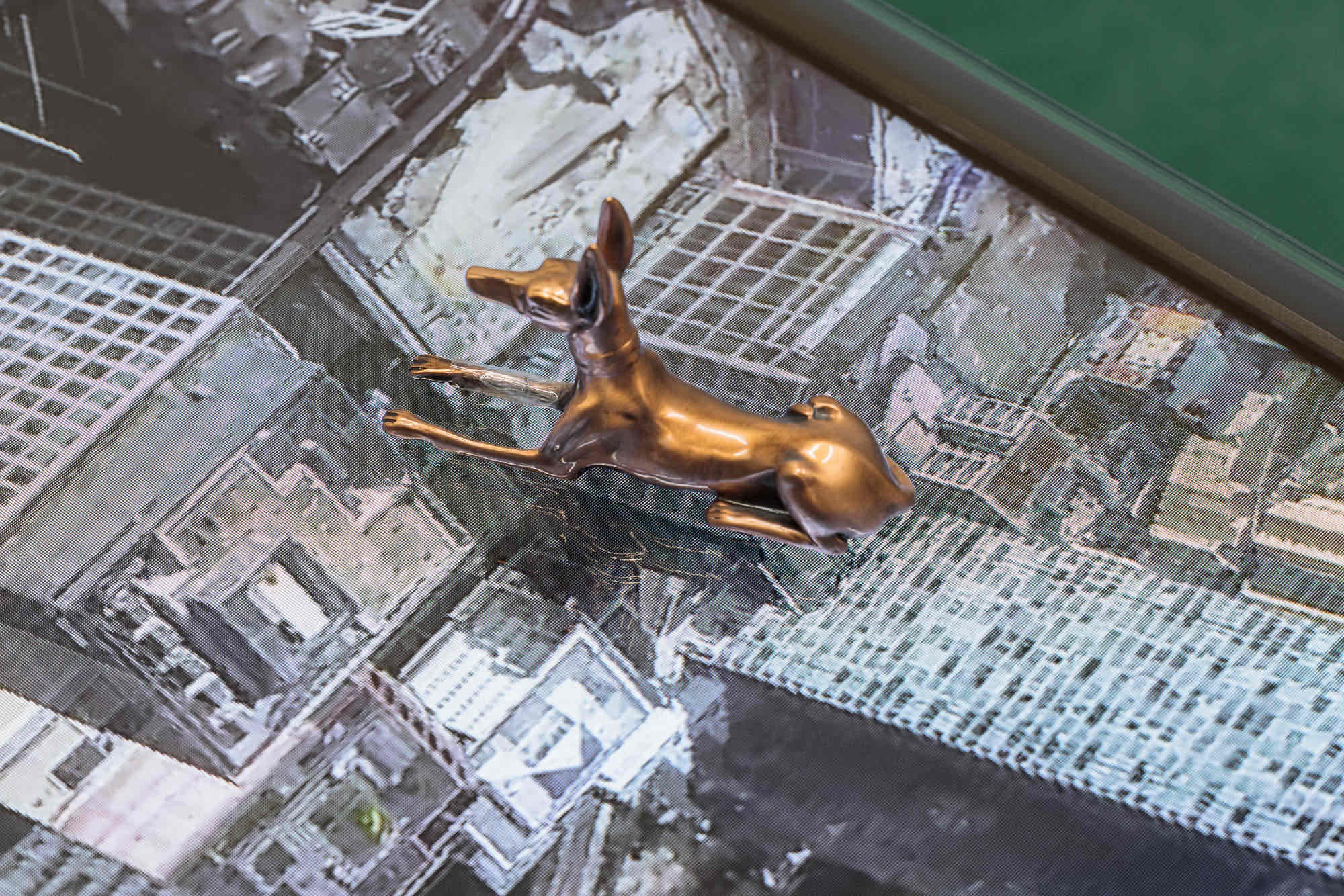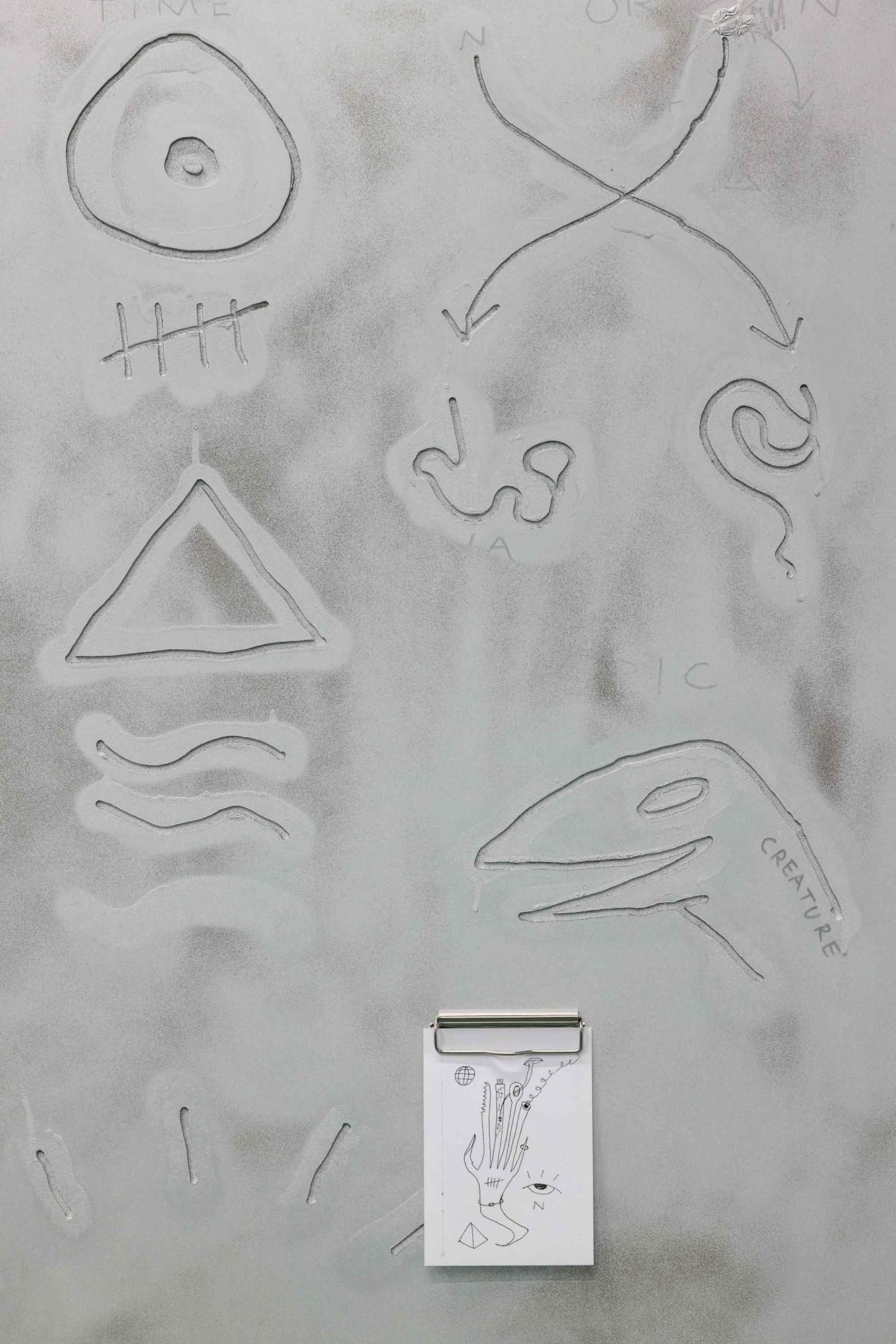Niko Abramidis &NE
GENHR
30 Sep - 26 Nov 2023

Agenda Table (3000 Years Agenda), 2015, steel, glass, LCD screen, anubis figure, chair, shoes, paper, 125 x 72 x 78 cm + objects, courtesy of the artist & max goelitz. Exhibition view Niko Abramidis &NE. GENHR, Salzburger Kunstverein 2023. photo: kunst-dokumentation

Cryptic Machine Prototype C2 (Bergkristall Update), 2021, steel, trackball, LCD screen, video loop
(57 sec), 110 x 86 x 11 cm, courtesy of the artist & max goelitz. Exhibition view Niko Abramidis &NE. GENHR, Salzburger Kunstverein 2023. photo: kunst-dokumentation
(57 sec), 110 x 86 x 11 cm, courtesy of the artist & max goelitz. Exhibition view Niko Abramidis &NE. GENHR, Salzburger Kunstverein 2023. photo: kunst-dokumentation

RSRCH PNL 4, 2023, spray paint, metal clip, paper, wood, 130 x 100 cm, courtesy of the artist & max goelitz. Exhibition view Niko Abramidis &NE. GENHR, Salzburger Kunstverein 2023. photo: kunst-dokumentation
The dialogue between the past, present, and future finds a form in Niko Abramidis’ solo exhibition GENHR at Salzburger Kunstverein. GENHR encapsulates Abramidis’ fascinations with a speculative archaeology of the future while delving into the mystique of human and machine synergies.
Abramidis, embodying a persona that transcends the individual—depicted through the &NE in his name—articulates his artworks as collective endeavors. This persona reflects an artist engaged in a constant dialogue with machine, economic spheres, and time’s inexorable march.
GENHR, the exhibition’s title, is a portmanteau of “genetics” and “human resources,” hinting at the layered examination of human intellect and technological advancements, fostering a bridge between the tangible and the elusive. Abramidis explains this term as a hybrid, embedding within it a contradiction between the generative capacity of human resources and technological overtures seeking to augment or replace them. The title also challenges the audience to unravel the duality it encapsulates—much like the exhibition urges them to dissect and understand the layered symbology embedded within each artwork.
The concept of “future archaeology” roots his exploration of unearthing dialogues between transient present and an imagined future. Through this lens, hieroglyphs for future civilizations are envisioned, portraying our present-day cultural zeitgeist. Abramidis’ art, much like ancient hieroglyphs, becomes a codex awaiting decipherment, offering glimpses into the ever-evolving narrative of human civilization.
Abramidis’ journey into the artistic realm began from a very instinctual practice: drawing. From doodling in notebook margins to responding to the rhythmic operations of machines in his mother's dressmaking workshop, foundations were laid in his interactions with the mundane for his inquisitive practice. A leap from architecture to the boundless freedom of art academy invigorated him in exploring and visualizing the dynamic between humans, machines, and their shared creative expressions.
Symbols form the nexus of Abramidis’ narrative. His meticulous crafting of logos and symbols invites viewers to decode complex, layered messages entwined within. He muses on how a single symbol can encapsulate a milieu of narratives, much as a fragment from the past can narrate volumes to future archaeologists. The symbols, both humorous and gravely serious, encapsulate a narrative, a thought, or a critique, mirroring multifaceted dialogues between humanity, technology, and the commercial landscapes that cradle them.
Abramidis’ engagement with machines forms a substantial crux in his works, transforming them into cohorts in his practice. The works in GENHR present a tableau of interfaces ranging from embroidery machines to AI algorithms. The alliance with technology doesn’t replace human capabilities but extends them, and in so doing spawns myriad expressions not bound by traditional mediums.
GENHR welcomes contemplation on our current societal fabric and echoes it in resonating into the future. Niko Abramidis provides an invitation to delve into this intricately woven narrative: to unearth, interpret, and perhaps contribute to today’s hieroglyphs for tomorrow's archaeologists.
Exhibition programmed by Séamus Kealy & curated by Mirela Baciak.
Abramidis, embodying a persona that transcends the individual—depicted through the &NE in his name—articulates his artworks as collective endeavors. This persona reflects an artist engaged in a constant dialogue with machine, economic spheres, and time’s inexorable march.
GENHR, the exhibition’s title, is a portmanteau of “genetics” and “human resources,” hinting at the layered examination of human intellect and technological advancements, fostering a bridge between the tangible and the elusive. Abramidis explains this term as a hybrid, embedding within it a contradiction between the generative capacity of human resources and technological overtures seeking to augment or replace them. The title also challenges the audience to unravel the duality it encapsulates—much like the exhibition urges them to dissect and understand the layered symbology embedded within each artwork.
The concept of “future archaeology” roots his exploration of unearthing dialogues between transient present and an imagined future. Through this lens, hieroglyphs for future civilizations are envisioned, portraying our present-day cultural zeitgeist. Abramidis’ art, much like ancient hieroglyphs, becomes a codex awaiting decipherment, offering glimpses into the ever-evolving narrative of human civilization.
Abramidis’ journey into the artistic realm began from a very instinctual practice: drawing. From doodling in notebook margins to responding to the rhythmic operations of machines in his mother's dressmaking workshop, foundations were laid in his interactions with the mundane for his inquisitive practice. A leap from architecture to the boundless freedom of art academy invigorated him in exploring and visualizing the dynamic between humans, machines, and their shared creative expressions.
Symbols form the nexus of Abramidis’ narrative. His meticulous crafting of logos and symbols invites viewers to decode complex, layered messages entwined within. He muses on how a single symbol can encapsulate a milieu of narratives, much as a fragment from the past can narrate volumes to future archaeologists. The symbols, both humorous and gravely serious, encapsulate a narrative, a thought, or a critique, mirroring multifaceted dialogues between humanity, technology, and the commercial landscapes that cradle them.
Abramidis’ engagement with machines forms a substantial crux in his works, transforming them into cohorts in his practice. The works in GENHR present a tableau of interfaces ranging from embroidery machines to AI algorithms. The alliance with technology doesn’t replace human capabilities but extends them, and in so doing spawns myriad expressions not bound by traditional mediums.
GENHR welcomes contemplation on our current societal fabric and echoes it in resonating into the future. Niko Abramidis provides an invitation to delve into this intricately woven narrative: to unearth, interpret, and perhaps contribute to today’s hieroglyphs for tomorrow's archaeologists.
Exhibition programmed by Séamus Kealy & curated by Mirela Baciak.


